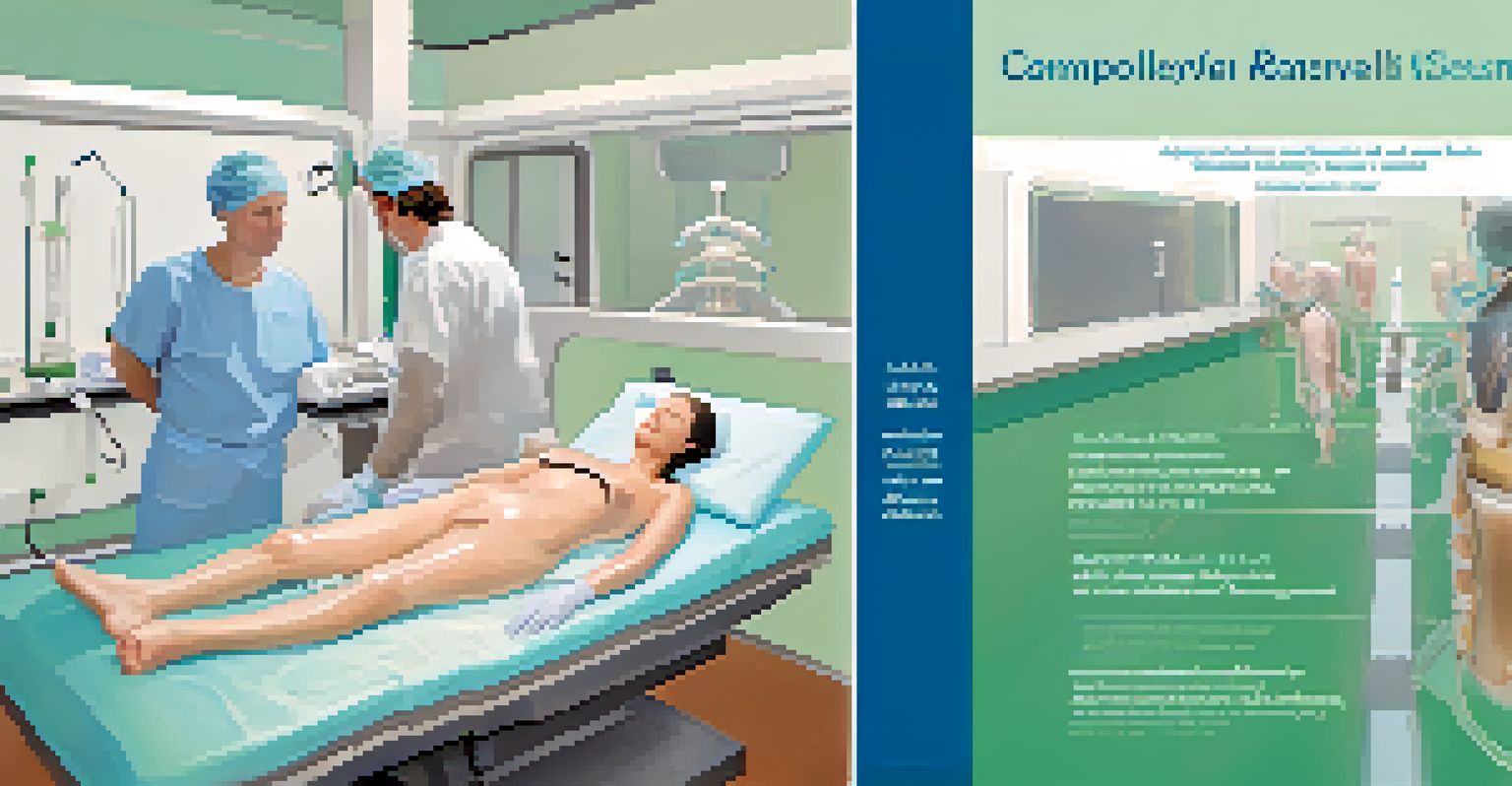Understanding Minimally Invasive Surgery and Its Benefits

What Is Minimally Invasive Surgery?
Minimally invasive surgery (MIS) refers to surgical techniques that require smaller incisions compared to traditional open surgeries. This approach often involves the use of specialized instruments, including cameras and robotic systems, which allow surgeons to operate with precision. The key principle behind MIS is to reduce trauma to the body, leading to quicker recovery times and less postoperative pain.
Surgery is the art of the surgeon's hands, but its success lies in the precision of their instruments.
In contrast to conventional surgery, where larger incisions are made, MIS often employs techniques such as laparoscopy or endoscopy. These methods not only enhance the surgeon's ability to visualize internal organs but also minimize damage to surrounding tissues. Imagine having a camera that allows you to navigate through a maze without tearing down the walls; that’s what MIS achieves in a surgical context.
As healthcare continues to evolve, the growing popularity of MIS highlights its importance in modern medicine. Patients today are more informed and often prefer options that promise faster recovery and less discomfort. Thus, understanding what MIS entails is crucial for anyone considering surgical options.
Advantages of Minimally Invasive Surgery
One of the most significant benefits of minimally invasive surgery is the reduced recovery time. Patients often find themselves back on their feet much sooner than those who undergo traditional procedures. This means less time spent in the hospital and more time enjoying life, which can be particularly appealing for busy individuals or those with family commitments.

Additionally, MIS typically results in less postoperative pain and scarring. Smaller incisions lead to less tissue damage, which translates to a more comfortable recovery experience. Think of it this way: the less you disturb a garden while planting seeds, the more beautiful and healthy it can grow. Similarly, minimal disturbance during surgery can lead to better healing.
Benefits of Minimally Invasive Surgery
Minimally invasive surgery offers reduced recovery times, less postoperative pain, and lower risks of complications compared to traditional surgery.
Furthermore, the lower risk of complications associated with minimally invasive techniques is a significant advantage. While no surgery is without risk, the precision of MIS often means fewer infections and shorter hospital stays. For many patients, this peace of mind is invaluable when facing surgical decisions.
Common Procedures Using Minimally Invasive Techniques
Minimally invasive surgery is used in various fields of medicine, including gynecology, urology, and orthopedics. Common procedures include laparoscopic gallbladder removal, hysterectomies, and knee arthroscopies. Each of these surgeries showcases how advanced techniques can improve patient outcomes while maintaining effectiveness.
The greatest risk is not taking one. In surgery, as in life, we must weigh our choices carefully.
For example, laparoscopic procedures allow surgeons to remove organs through tiny incisions, which is a game changer for patients needing gallbladder surgery. Instead of a long recovery period, patients often go home the same day. This shift not only enhances the patient experience but also optimizes hospital resources.
In addition to traditional areas, the adoption of robotic-assisted surgery is becoming increasingly popular. These systems offer surgeons enhanced precision and control, allowing for even more complex procedures to be performed minimally invasively. The future of surgery is indeed bright with these innovations.
Who Is a Candidate for Minimally Invasive Surgery?
Not every patient is a suitable candidate for minimally invasive surgery, but many can benefit from it. Factors such as the type of condition being treated, the patient's overall health, and the surgeon's expertise all play a role in determining eligibility. Generally, MIS is well-suited for patients who are in good health and have localized issues.
For instance, individuals with gallstones or hernias are often excellent candidates for laparoscopic procedures. Conversely, patients with multiple health complications may require more traditional approaches to ensure their safety during surgery. It's essential for patients to discuss their unique situations with their healthcare providers to determine the best surgical options.
Who Can Benefit from MIS?
Patients in good health with localized issues, such as gallstones or hernias, are often ideal candidates for minimally invasive procedures.
Ultimately, the goal is to provide the best possible care tailored to each individual’s needs. Open communication between the patient and the medical team can help identify whether MIS is the right choice, ensuring a personalized approach to treatment.
Risks and Considerations of Minimally Invasive Surgery
While minimally invasive surgery offers numerous benefits, it is not without risks. Potential complications can include bleeding, infection, or damage to surrounding organs. It’s crucial for patients to weigh these risks against the advantages and consult their surgeons about any concerns.
Moreover, the learning curve associated with these advanced techniques can vary between surgeons. Not all practitioners have the same level of experience with MIS, which can influence the outcome of the procedure. Like any skilled trade, proficiency improves with practice, so it’s wise to seek out a surgeon who specializes in minimally invasive techniques.
Lastly, patients should consider their personal health conditions before opting for MIS. Certain factors, such as obesity or previous surgeries, may increase the likelihood of complications. Discussing these issues openly with the surgical team can help ensure that the approach chosen is the safest and most effective.
The Future of Minimally Invasive Surgery
The future of minimally invasive surgery is promising, with ongoing advancements in technology and technique. Innovations such as enhanced imaging systems and robotic technology are set to further revolutionize surgical practices. These tools not only improve the precision of surgeries but also expand the range of procedures that can be performed minimally invasively.
Furthermore, research in the field continues to uncover new applications for MIS, leading to its adoption in more complex surgeries. As techniques improve, patients can expect even better outcomes and fewer complications. Imagine a world where major surgeries are performed with the same ease as a routine check-up; that’s the direction we’re heading.
Future of Minimally Invasive Surgery
Advancements in technology, including robotic systems and artificial intelligence, are set to enhance the precision and range of minimally invasive surgical techniques.
As we look ahead, the integration of artificial intelligence and machine learning into surgical practices could also enhance decision-making and patient care. This evolution promises to make surgeries safer and more efficient, ultimately benefiting patients and healthcare providers alike.
Making an Informed Decision About Surgery
Deciding to undergo surgery is a significant step, and it’s crucial that patients feel informed and empowered throughout the process. Researching options, understanding different surgical techniques, and asking questions are vital parts of this journey. Patients should never hesitate to seek second opinions or gather information from trusted sources.
Additionally, discussing personal goals and concerns with healthcare providers can lead to better outcomes. Every patient’s situation is unique, and what works for one person may not be the best choice for another. Emphasizing open dialogue with medical teams can pave the way for tailored solutions that align with individual needs.

Ultimately, being proactive in one’s healthcare journey can lead to more positive experiences and outcomes. Knowledge is power, and understanding the nuances of minimally invasive surgery can help patients make decisions that truly reflect their health goals.